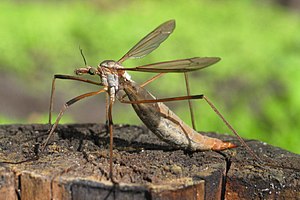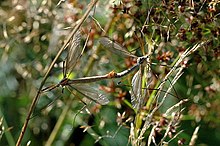Wiesenschnake
| Wiesenschnake | ||||||||||||
|---|---|---|---|---|---|---|---|---|---|---|---|---|

Meadow snake ( Tipula paludosa ), female |
||||||||||||
| Systematics | ||||||||||||
|
||||||||||||
| Scientific name | ||||||||||||
| Tipula paludosa | ||||||||||||
| Meigen , 1830 |
The meadow snake or swamp snake ( Tipula paludosa ) is a species from the snake family .
features
Adults
The Wiesenschnake is a relatively large species of mosquito. Males are 16 to 18 millimeters long, females 19 to 25 millimeters. The wings are 16 millimeters long or longer, with the males having noticeably longer wings than the females. The animals are monochrome brownish-gray in color, with the females tending to predominate in the brown tint. As with almost all Tipulidae, the body is elongated with a cylindrical abdomen , the legs are remarkably long and thin, the wings spread diagonally from the body when at rest. On closer inspection, there is a v-shaped suture on the thorax and the lack of point eyes ( ocelles ). Furthermore, the head is extended in front of the eyes into an appendage called the rostrum. In Tipula paludosa and the related species the antennae have no protrusions or appendages, but each limb has a whorl of long hair bristles. The wings are clear and unspotted. A closer look reveals that the foremost wing field ( costal field ) is a little darker in color. Directly behind it, the wing membrane has a milky white clouded, blurred wipe (best seen against a dark background).
In Tipula paludosa , the antennae in males and females are fourteen-membered, in most related species they have only thirteen segments. To determine the Tipula species reliably , however, the genital formation of males and females must be compared. In females, the last (ninth) abdominal segment is elongated and pointed; it has two pairs of long appendages, the cerci and the hypovalvae. These together form an ovipositor for laying eggs. In males, the ninth abdominal segment is shorter; it is transformed into a reproductive organ called the hypopygium . The rear extension of the ninth sternite and two pairs of hook-shaped appendages are species-specific . In this species, the hypopyg is drawn out into a lateral appendage, which is not narrower at the tip than in the basal part, it has a row with about 15 golden-yellow bristle hairs on the upper edge.
Although a reliable identification of Tipula paludosa is difficult, it is relatively easy to distinguish the species from the cabbage snake Tipula oleracea , with which it often occurs (the other Tipula species are normally only to be expected in swamps or near water). In Tipula paludosa the complex eyes are relatively far apart when looking at the head from below (!), Always wider than the length of the first antennae. In oleracea , the space between them is much smaller, the eyes almost butt against each other. In addition, in the females of paludosa the wings are shorter than the abdomen, in oleracea longer. The inner process of the hyxpopyg is much narrower in oleracea and tapers outwards, it does not have a yellow row of bristles .
Larvae
The larvae of the tipulids are long, cylindrically shaped animals without legs or lateral appendages. The head capsule is hard sclerotized, but very small and can be pulled back into the trunk ("hemicephalic" head formation). Most conspicuous and essential for a determination is the rear end of the larva. This carries the stigmas on a dark, sclerotized plate . This plate is surrounded by six flap-like appendages, four closer together in pairs on the dorsal side and one slightly separated pair on the ventral side. This formation has reminded imaginative viewers of a face with large dark eyes and horns and is therefore known as the "devil's face". Below these processes, on the ventral side, there is a different number of retractable and retractable anal papillae. In 'Tipula paludosa' and related species, the lobes of the “devil's face” are white and not sclerotized, relatively short and rounded, and almost equally long. There are two pairs of anal papillae, the upper one of which is elongated and pointed and the lower of which is very short and rounded. The larvae are not colored white like most mosquito larvae, but brownish (but without noticeable longitudinal stripes), the cuticle is coarse and leathery (in English-speaking countries it is therefore referred to as "leatherjacket"). In the last stage, the larvae reach a length of 44 millimeters. However, it is not possible to reliably differentiate the larvae of Tipula paludosa from the related species of the subgenus Tipula (including oleracea ).
Dolls
The tipulid pupae are elongated, cylindrical with three fused thoracic and eight free abdominal segments. They carry rows of short thorns in a ring around the abdominal segments. At the front of the prothorax are two antenna-like extensions, the so-called breathing horns. The pupae have free wing sheaths that extend to the second abdominal segment, and leg sheaths that lie between them and extend straight and parallel to each other to the third or fourth segment. At the head end the sheaths of antennae and maxillary palps can also be seen. The spines of the eighth abdominal segment are important for differentiating between species and groups of species. This bears seven pairs of strong thorns. A determination can be attempted with, but it is uncertain.
Life cycle
The Wiesenschnake has one generation per year. The adults fly in late summer to autumn, around August to October. Often in meadows at this time one can observe coupled couples in copula. The animals hang together with their rear ends and bodies facing in opposite directions; in this position they can fly. The adults are short-lived, usually mating immediately after hatching. At this point, the female is already carrying the fully formed eggs in her abdomen. Due to its short wings, it is only able to fly to a limited extent and can hardly cover distances longer than about five meters in the air, so it only occurs near the larvae 's habitats. After fertilization, it lays the eggs about 5 millimeters deep in the soil and then dies. Often dead animals can be found that have not managed to lay all of their eggs. Around 300 to 500 eggs are laid per female.
The first larval stage hatches from the eggs after 11 to 15 days. The third larval stage overwinters. The larvae live almost exclusively in the topmost soil layer, up to a depth of about 2.5 centimeters, and they also overwinter there. In the following June the fourth larval stage is reached, this weighs about 300 to 500 milligrams. After reaching their maximum size, the larvae take a break of six to eight weeks. The pre-pupal stage that precedes pupation crawls a little deeper into the ground, but then loses its mobility and pupates. Before hatching, the pupa (actually: the finished imago enclosed in the pupa’s skin) crawls to the surface of the ground with undulating movements. The hatching from the doll's skin usually takes place with the front body free, while the rear end is still in the ground.
Ecology and way of life
The Wiesenschnake is a type of open, unforested habitat. In contrast to most related species, it does not have its main distribution center in swamps or bodies of water, but prefers fresh, medium soils. It is often found in habitats with a closed grass cover, especially agricultural grassland. It inhabits meadows and pastures, but also lawns of all kinds. In these habitats it often occurs together with the cabbage schnake. It is not completely absent in swamps, but is mostly replaced by related species. The species is quite sensitive to flooding of the soil surface.
The larvae feed as herbivores , primarily root-eating (rhizophag) from the grass roots just below the soil surface, but also from parts of plants growing above ground. In addition, the larvae leave their passages in the earth especially at night. In overcast, rainy weather, feeding activity can also be observed during the day.
Economic importance
In the case of mass occurrences, caused by cool, damp weather at the time of egg development and the first larval stage, as well as mild winters, the meadow schnake can cause damage to lawns . On well-tended lawns, a strong occurrence of the meadow schnake can be recognized by reduced growth, yellow-brown discoloration of the leaves and the appearance of nest-shaped bald spots. Similar damage can often also be observed in agricultural grassland. Damage in grain fields occurs, but is less common. Here they are often tied to freshly plowed grassland areas. Young seedlings can be bitten off at the level of the soil surface, the shoots and leaves are often also partially eaten. The species is largely tied to grasses, damage to non-grassy species such as vegetable crops is more likely to be traced back to the cabbage schnake.
If the infestation is severe, meadow snakes are often controlled with the use of pesticides . There are also attempts at biological control by means of a specific virus (“Tipula iridescent virus”).
distribution
The Wiesenschnake is a western to central European species. It lives on the Iberian Peninsula (Spain and Portugal) across western and central Europe, including Great Britain and Ireland, north to the Faroe Islands and central Sweden. The eastern limit of distribution is already in eastern Central Europe, the species is only found sporadically as far as western Ukraine. In the south it is restricted to northern Italy and the northern Balkans and is absent on the peninsulas proper.
The species was introduced to North America, where it is widespread today. The first evidence is from Cape Breton Island , Nova Scotia , from 1955 . The first economic damage from Newfoundland was reported as early as 1959. In 1965 the species reached Vancouver ( British Columbia ) and thus the Pacific coast. In 1980/1981 there was a mass occurrence in Washington state with high economic damage. The southern limit of the distribution is approximately at the 45th parallel . The reported economic damage appears to be higher in North America than in Europe.
Individual evidence
- ^ Bernhard Mannheims: 15. Family Tipulidae. In: Erwin Lindner (editor): The flies of the Palearctic region. Volume III, 5th Partial Volume. 1951, new edition and additions 1980. Schweizerbart Verlag ISBN 978-3-510-43013-0 .
- ↑ E. Richard Hoebeke and Carolyn Klass: Tipula paludosa Meigen and T. oleracea Meigen, European Crane Flies New to the Eastern United States: Potentially Serious, Turfgrass and Pasture Pest PDF
- ↑ John Skartveit (2006): Tipula oleracea Linnaeus, 1758, in Norway, with a key to the Norwegian Tipula (Diptera Tipulidae) (s. Str.) (S str..). Norwegian Journal of Entomology 53: 1-4.
- ^ A b Allan Brindle (1960): The larvae and pupae of the British Tipulidae and Cylindotomidae (Diptera: Tipulidae). Transactions of the Society for British Entomology 14 Part III: 19-114.
- ^ A b c David Michael Jackson & R. Lee Campbell (1975): Biology of the European Crane Fly, Tipula paludosa Meigen, in western Washington (Diptera, Tipulidae). College of Agriculture Research Center, Washington State University, Technical Bulletin No. 81
- ^ R. Laughlin (1967): Biology of Tipula paludosa; growth of the larva in the field. Entomologia Experimentalis et Applicata 10: 52-68. doi : 10.1111 / j.1570-7458.1967.tb00044.x
- ^ RP Blackshaw & C. Coll (1999): Economically important leatherjackets of grassland and cereals: biology, impact and control. Integrated Pest Management Reviews 4: 143-160.
- ↑ B. Theowald (1984): Taxonomy, phylogeny and biogeography of the subgenus Tipula (Tipula) Linnaeus, 1758 (Insecta, Diptera, Tipulidae). Tijdschrift voor Entomologie 127: 33-78.
- ↑ B. Theowald & P. Oosterbroek (2983): On the zoogeography of the western Palearctic Tipulids. III .: The tipulids of the European lowlands (Diptera, Tipulidae). Bonn Zoological Contributions 34 (1–3): 371–394.
Web links
Catalog of the Craneflies of the World
